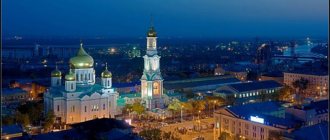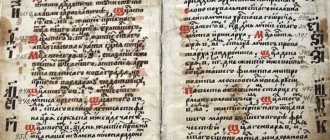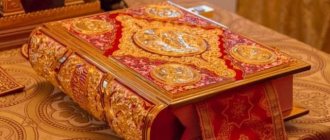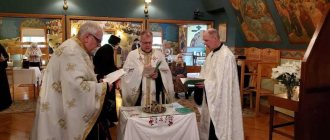| Melania (Pakhomova), recluse of the Yeletsky Znamensky Monastery |
Melania (Pakhomova)
(1759 - 1836), recluse of the Yeletsk Znamensky Monastery. Born in 1759 in the Lamskaya settlement of the Yeletsk district of the Oryol province, into a poor pious family. The hardworking, young and beautiful girl Melania loved the Lord from a young age. She avoided worldly pleasures and often spent time in the temple. When, after the death of her parents, she had to get married, she secretly left home and in 1778 settled as a novice in the Znamenskaya monastery on Kamennaya Gora. Having learned about Melania's whereabouts, her relatives persistently asked her to return home and marry, otherwise they threatened to deprive her of their inheritance. But she remained adamant.
In the Znamensky Monastery, Melania labored for 58 years in unceasing fasting and prayer. The only food she took was bread and water. She always wore shabby clothes with frequent patches.
For twenty-two years, her younger sister Catherine lived with Melania in the monastery. After her death, Melania began to act as a fool, but temptations began, and she was dissuaded from the feat of foolishness by her contemporary ascetics: Fr. John Zhdanov, Hilarion Troekurovsky and the holy fool John Kamenev.
On August 6, 1819, Melania, having received the Holy Mysteries of Christ, took upon herself the voluntary feat of seclusion. From that moment until her death (17 years old), she did not leave her cell, intensifying her spiritual exploits. She acquired the gift of insight and spiritual healing of bodily and mental ailments, and had a revelation from God about the very day and hour of her death [1].
She died on June 11 [2] 1836. She was found lying on the floor of her cell, with her face turned to the image of the Savior Christ. She was buried near the cathedral Church of the Sign.
Wonderful signs accompanied her death. Travelers returning from Zadonsk saw a pillar of fire standing over Stone Mountain. Numerous healings of the sick were performed. Numerous miracles flowing from her coffin prompted the monastery authorities to keep a special book for recording them, and admirers of the blessed one built a cast-iron monument-chapel over her coffin.
Used materials
- A. Voskresensky. The city of Yelets in its present and past (a historical sketch experience). Yelets, 1911.
- Maxim Vasilievich Polosin. “Three discoveries of the Znamensky Monastery on Stone Mountain”
- “Russian Monk” No. 39, August 1911. Recluse Melania
[1] Chapter IX. The death of the recluse Melania and the great sympathy of the people for her // Biography of the maiden Melania the recluse of Yeletsky Znamensky, on Kamennaya Mountain, nunnery. - [B. m.]: Zadonsk Nativity-Bogoroditsky Monastery, 2006. - pp. 73-74. —
[2] Date according to the biography of the Publishing House of the Zadonsk Nativity of the Bogorodsky Monastery. According to some other sources - July 11 ("Russian Monk" No. 39, August 1911. Recluse Melania -)
Melania the recluse presentation for a local history lesson on the topic
Slide 1
Devotees of the Yeletsk convent. Melania is a recluse.
Slide 2
In 1759 in the settlement of Lamskaya, Yelets district, Oryol province. In the poor but pious Pakhomov family, a daughter was born - Melania, the future recluse of the Znamensky Yelets Monastery, who with her strict life acquired a good memory among the people, indelible even to this day.
Slide 3
“From the days of adolescence,” says the compiler of the biography of the ascetic of God, “she already felt an attraction to a solitary, contemplative life.” Hardworking, like a bee, young and beautiful, Melania did not seek pleasure in the world; Every holiday, every day not dedicated to rural work, she was in the temple of God, enjoying prayer, delving into church reading and singing.
Slide 4
Nothing worldly attracted her; she longed to follow Christ, and when, after the death of her parents, she had to get married, she secretly disappeared from her home and settled as a novice in the Znamenskaya monastery. In vain, Melania’s relatives asked her to marry, promising to deprive her of her home, inheritance, and even family love if she disagreed.
Slide 5
But Melania, placing all her hope in the Lord and His Most Pure Mother, did not leave the monastery, but remained in it forever.
Slide 6
“Her spirit burned with the desire for exploits, which she listened to attentively while reading the lives of the saints...” “At night she did not give herself rest, but while awake she constantly repeated prayers to the Lord.” “Always abstaining from food, she could soon be content with bread and water, and then in moderation.”
Slide 7
Soon the Lord unexpectedly sent her instruction in the person of Elder Hilarion Troekurovsky, who visited the Znamensky Monastery. “Sit in your cell and prepare yourself for complete silence and a reclusive life!” Do this, and I will pray for you and the Lord will help you! - Illarion consoled her.
Slide 8
In August 1819, Melania, having received the Holy Mysteries and prayed to the Mother of God, entered her dim, cramped cell and did not leave it until the day of her death.
Slide 9
Secluded from people, Melania, without noticing the time, stood in prayer sometimes for whole days. The other nuns wondered: is it possible to maintain such vigil? “Perhaps,” the ascetic answered them, “for from my youth I accustomed myself to being awake at night.” Fasting and silence helped me in this, and besides, when sleep burdened me, I tied my head by my hair, to the wall where the nails were driven, so that if I leaned over in a drowsiness, I could immediately wake up again.
Slide 10
The highly ascetic life of the humble recluse Melania brought down the grace of God on her and the righteous Lord generously enriched His faithful servant with extraordinary gifts - she could see the future - she spoke allegorically to some of those who visited her, and to others she clearly predicted a change in their lives in the distant future.
Slide 11
Once Melania sent to the house of her benefactress, the good merchant Gavrilova, to ask her for a watermelon. She, being busy with housework, grumbled that time, but sent a watermelon. Having received the watermelon, blessed Melania looked at it for a long time; then she cut out a heart in it and, having poured quite a bit of ash into it, closed it again and sent it back. A good friend understood this parable and repented of her action.
Slide 12
Two women came to Melania to ask for prayers and blessings: one of them, poor, prepared her a kalach and was ashamed that she had no more. Another bought pretzels and thought: well, where does she need so many? As soon as they approached her window and, having said a prayer, knocked, they heard blessed Melania say first: “I’m hungry.” Give me your roll,” and kissed him. And the other answered: “I bought some good stuff!” Dry and black! Eat by yourself, I don't need them. And she didn’t take them.
Slide 13
The fast of the holy apostles Peter and Paul has begun. Melania began to prepare to receive the Holy Mysteries; on the very day of communion, the priest walked towards her from the church with the holy gifts, and the cleric carried a lighted candle ahead. Suddenly a strong wind blew and the candle went out. The priest wanted to return to light a candle in the church, but the priest, hastening him, said: “We’ll light it there.” When they walked through the entire monastery and the priest stepped onto the threshold of the recluse’s cell, the candle in his hands lit up by itself. He placed it on the table with trepidation. After the sacrament was completed, he brought a burning candle to the church. This wonderful lighting of the candle was noticed by everyone.
Slide 14
Melania often came to the house of the Lavrovs, who were her benefactors, and had a long conversation there with Father Hilarion, the future famous recluse Troekurovsky. Yelets merchant Mikhail Ivanovich Lavrov later said more than once: “I owe all my capital to the prayers of Father Hilarion.” Since he came to live with us, God has blessed my house with all abundance; and where there should have been losses in our trade, there were unexpectedly profits. And indeed, the house of Lavrov has risen since then, and, dying, the benefactor of Father Hilarion left a rich inheritance to his three sons.
Slide 15
At one time, Blessed John, later the famous Sezonovsky recluse, visited Stone Mountain, and, having fallen ill, fell as if lifeless in Melania’s cell: she lit coal in the censer and burned the man who was lying with incense; he stood up and, strengthened, could talk with her. Since then, he had great respect for Melania and told many that through the prayers of the humble Melania he had repeatedly received healings.
Slide 16
In the Yeletsky Znamensky Monastery, the recluse Melania was famous for her clairvoyance. One day, nun Lyubov, who had suffered for a long time from swelling, aching and a serious illness in her legs, sent her novice to her to ask for her holy prayers. Melania gave the novice a pinch of tea and ordered the patient to be given something to drink immediately. In the morning, the patient felt better and decided, trusting in the Lord, to no longer bother the recluse about her health. Some time later, on another matter, she again sent her novice to Melania. On the way, the novice thought to herself: “Truly, our recluse is a saint of God!” With this thought and saying a prayer, she knocked on Melania’s window. The door immediately opened, and Melania harshly told her: “What do you call me?!” I'm poor and blind! If you call me that, forget the way here! Tell the sick nun to buy some rolls in a week and bring them to me herself. And so it came true. The patient recovered without medication, to the surprise of everyone, and on the appointed day she herself brought the rolls to her healer.
Slide 17
In constant labors, in close seclusion, healing spiritual wounds, and often through the power of prayer, physical ailments of people, instructing them in the Christian life, Elder Melania peacefully reposed in the Lord on July 11, 1836.
Slide 18
Elder Sergius regretted that the portrait of the recluse Melania had not been removed recently, and with his conversations he inspired others with the same regret. She appeared to him in a dream and ordered him to take a good look at her facial features. He saw her with a large shining cross in her hands, and according to his story, the painter depicted her likeness so successfully that everyone who knew her personally finds the portrait very similar. Only the artist’s hand could not depict the already unearthly beauty and glory that shone upon her in this dream.
Story
The convent of the city of Yelets has a centuries-old historical path. Despite the value of the architectural structure and the spiritual development of the monastery, it, like many other Orthodox shrines, suffered at the hands of Soviet power. Revival and reconstruction work began only in the 21st century.
Base
The history of the Znamensky Convent in the city of Yelets dates back to the first half of the 17th century. In 1628-1629, the Yelets abbot of the monastery of St. Moses built a monastery. The monastery was founded on the site of the “old settlement” (near a steep stone cape with a ravine called Verkh Kamenny). A wooden church named after the icon of the Nativity of the Blessed Virgin Mary was erected here.
Several cells were built near the temple. The elders of the Trinity Monastery lived there, desiring solitude and separation from the bustle of the world. In 1657, on the territory of a remote monastery that belonged to the Trinity Monastery, there were already 5 monks. Their solitude was interrupted in 1683 by Saint Yeletsky. He transferred the novices back to the walls of the Trinity Monastery.
In the second half of the 18th century (1683) the monastery was converted into a convent. This date is considered to be the time of the founding of the new monastery. This event happened thanks to the works of the Voronezh Bishop Mitrofan the Saint.
Iulitta was chosen as the first abbess of the holy monastery. She managed the monastery for more than 15 years. At this time, the territory of the convent expanded. Two churches were built here: St. Nicholas and the Nativity of the Most Pure Mother of God. At that time, 27 novices lived within the walls of the monastery. Peter 1 issued a decree assigning land ownership to the monastery along with the peasants living in this territory.
Catherine 2 in 1764 signed a decree regarding the simplification of the monastery. Despite the restrictions, the nuns did not leave the walls of the monastery. Five years later (1769) there was a fire in the city, due to which all the monastery buildings burned down.
Among the ashes left from the monastery, there lived 2 nuns (80-year-old Agafya and 60-year-old Ksenia), who refused to leave the site of the tragedy, while tirelessly praying for the revival of the shrine. The blessed elders lived in a cellar, part of which survived the fire. The top of the dwelling was covered with tree branches and smeared with a small ball of clay.
The old women, who showed humility and remained at the site of the ashes, were respected not only by the townspeople, but also by Tikhon the Saint, who at that time found himself within the walls of the Mother of God of Zadonsk Monastery. Knowing about the sorrows of the nuns, the cause of which was the fire, Tikhon sent the schema-monk Mitrofan to Yelets to encourage the spirit of the sufferers, as well as help in the matter of restoration.
Soon after this, blessed Agafya died. In order not to leave Sister Ksenia alone, with the blessing of Mitrofan, Matrona Solntsevaya, who had previously been in the Voronezh Intercession Convent, joined her in 1772.
Thanks to the efforts of Orthodox peasants, a small wooden church named after the icon of “Theotokos of the Most Holy Sign” was built on the site of the ashes. A parish with 29 households was founded on the church territory.
The number of sisters grew steadily. The nuns submitted a petition for permission to restore the lost monastery. In 1774 an official response came, which stated that the request was refused. The reason was that at that time there were a sufficient number of Orthodox monasteries on Russian soil, so Empress Catherine did not approve of the construction.
In 1778, Sister Melania came here, a blessed ascetic who lived within the walls of the monastery for more than 58 years. She died in seclusion during tireless prayer in 1836. To this day, all parishioners and novices of the monastery who ask for help from the ascetic Melania receive it.
Saint Tikhon often visited the walls of the monastery. When visiting Yelets in 1779 for the last time, he blessed the sisters of the monastery, and also chose the site for the construction of a new church made of stone. In 1804-1813, construction work was carried out on the Church of the Icon of the Most Holy Theotokos “The Sign”.
In 1795 there were 21 cells, where 41 nuns lived. All monastery buildings were surrounded by a wooden fence consisting of columns. The existence of the monastery was actually illegal. Despite the resistance of the sisters, as well as city residents, in October 1795 the provincial authorities were forced to liquidate the remains of the monastery buildings. The buildings were subject to demolition or sale. Despite the existence of the instruction, it was not implemented.
Officially, the monastic position was illegal. Residents of the city, as well as the nuns of the monastery, repeatedly complained about this to the local authorities. The request was granted, and in 1822, by imperial decree of Alexander 1, the monastery was reopened.
During this period, the sisterhood of the convent numbered 117 novices. They had 46 cells at their disposal. The Holy Synod granted the monastery the right to be a third-class monastery.
On March 23, 1823, Taranova Glafira became the abbess of the monastery. Before that, she was a novice at the Oryol Introduction nunnery. The assistant to the new abbess was the Matrona of the Sun, who joined Elder Ksenia, who remained in the ashes after the fire following the death of Agafya.
The revival of the monastery began. A new refectory, bell tower, and brick fence with large gates and towers were built. On the south side, in 1841, a wide staircase leading down to the waters of the holy spring was built. In 1861, the construction of the bell tower, consisting of 3 tiers, was completed. There were more than 10 bells here, the largest of which weighed more than 3 tons. The surrounding areas, like the monastery itself, continued to expand.
The mid-19th century saw the period of the most active expansion of the monastery's territories. The total length of the monastery wall exceeded 1200 meters. More than 200 novices lived within the monastery walls, located in 67 cells. In order to improve living conditions, a new residential building was built, the height of which was 2 floors.
In 1885, the Holy Gates were installed, located in the southern part of the monastery. They depicted saints of God, as well as some religious motifs. The gate, together with the staircase leading to the Holy Spring, which was also located on the south side, created a picturesque landscape.
In 1890, a school for girls was opened on the territory of the convent. The parochial educational institution taught teachers handicrafts and literacy. The school's mentors were the monastery sisters and local priests. The classes were held free of charge for everyone. More than 100 girls studied here. The educational building was two-story, and was located in the southern part of the monastery territory.
The image of the Most Pure Mother of God “The Sign” was considered the largest shrine of the monastery. The icon miraculously survived the fire of 1769. It was this image that saved the monastery during the great fire of 1847, where most of the city was damaged. Nowadays, the icon is located within the monastery walls. A large number of pilgrims will come here to pray at the miraculous image and ask for healing.
At the beginning of the 20th century, the monastery owned 150 buildings, and more than 400 novices lived within its walls. The Znamensky Monastery housed the “Three-Handed” icon, created on Mount Athos. Here was the holy image of the Mother of God.
The arrival of Soviet power
The monastery was closed immediately after the October Revolution. Divine services within the walls of the women's monastery did not stop. At the head of the spiritual militia was Abbess Antonina, who refused to leave the monastery.
In 1929, the time came to divide the property of the Znamenskaya Convent. The sisters were forcibly expelled from their cells. Subsequently, most were sent to camps or prisons. Abbess Antonia was killed after brutal torture due to her refusal to leave the monastery.
The name of the Znamensky Monastery was officially renamed to “Workers' Town”. Over time, temples and churches where services were once held fell into disrepair. In 1937, the main cathedral of the Znamensky Monastery was destroyed.
Renaissance
At the beginning of the 21st century, only a few buildings survived due to a long period of abandonment, the condition of which was deplorable. The list of surviving objects includes several monastery cells, the walls of the building itself and the staircase leading to the holy spring.
By the decision of the Synod of the Holy Orthodox Russian Church, the monastery was reopened in 2004. In June of the same year, the foundation of a chapel named after the icon of the Mother of God “Life-Giving Spring” took place near the destroyed monastery walls. The event marked the beginning of a long recovery period that continues to this day. Residents of the city and parishioners of the monastery have been preparing for the revival for several years, cleaning up the surrounding areas, as well as improving the grave where the recluse Blessed Melania was buried.
- In 2005, a small chapel was built near the holy spring located on the territory of the monastery. At the same time, construction work began on the restoration of the Znamensky Convent.
- In the winter of 2005, the Church of the Savior and Nativity of the Cross was transferred to the Znamensky Monastery for holding divine liturgies. The church is located on the other side of the river, located in the city of Yelets, but is clearly visible from the monastery territory. After several months of preparatory work, liturgies began to be held in the church for the sisters of the monastery, as well as Orthodox parishioners.
- In 2006, a wooden church named after the Wonderworker Savior Nicholas was built. The consecration of the temple took place by Bishop Nikon in December 2006.
Today, restoration work on the reconstruction and improvement of the monastery territory continues. A new bell tower, a refectory, and a building for the sisters' cells were built.
At the moment, 16 nuns, 7 schema nuns and 4 nuns live within the monastery walls. Around the clock, within the walls of the temple, prayers are performed to help improve the monastery, and the Psalter of Peace and Health is read for the relatives and friends of the parishioners.










